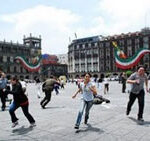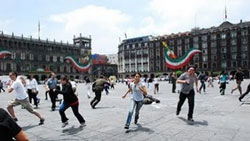
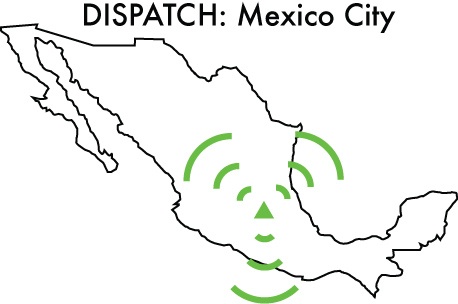
This DISPATCH addresses the case of a growing scene at the intersection of education, pedagogy and art in Mexico.
At this particular time there seems to be a collective, urgent demand for alternative strategies that provide new relationships of knowledge production and spaces for dialogue and encounter.
In recent years, artist-led, self-organized, institutional and private educational initiatives in the contemporary art scene have opened up an active debate on the intersections of education and art. A number of artist-instigated educational projects have emerged, many of which are independently staged, while others are institutionally framed, and some privately funded.
Within the contemporary art circuit, through many differences regarding perspectives, positions and objectives, universities, museums, and independent spaces in Mexico openly address questions and activate speculation on the relationship between education and art. As yet, there is no consensus on the concepts (and specific uses) of education and pedagogy, but proposals from artists and scholars test various ideas and approaches.
This emerging movement is connected to broader phenomena of increasing attention to these themes in the international sphere. The Mexican cases share similar concerns to those being globally discussed, but they also embrace a contrasting complexity that comes from the particular conditions in which they exist.
The last decades have witnessed a decline in the standards of public education and educational policies in Mexico. Serious impoverishment of working conditions and institutional resources for educators in regions such as Oaxaca, Guerrero, Morelos and Mexico City have led to increasing demonstrations, open confrontation and even triggered organized armed movements by teachers, brutally oppressed by police and national military forces. Conversely, the National Education Workers Union (SENTE) is today one of the most powerful political forces in the country, influencing government negotiations even beyond education interests. All these elements have created a climate of increasing tension and ambiguity regarding the distribution of resources for the development of education.
Thus, it is clear that the context from which new projects continue to emerge is complex and paradoxical. The effects of this panorama are still to be seen.
A non-exhaustive background
Emerging initiatives inherit the artistic strategies put in practice by art circles in the past decades. Discussion groups, collective practice, artist-run spaces, academic forums and international networks, were important education-driven precedents that are present in todays proposals.
Discussion groups were common in intellectual circles during the Muralist movement in the 1930s in which political models, social engagement, and public education were at the center of artistic debate.
Collective practice was the axis of the 70s generation, activated by groups such as Proceso Pentagono, No-Grupo, Grupo Suma, and TAI (Art and Ideology Workshop) among others. Public action, urgent social response, and critical thought, were motivated by post 68 reflexive processes.
Artist-run spaces emerged in the late 80s, providing physical frames for study groups and festive reunions. La Quiñonera (1988), an open house with artist studios, was the generations iconic multidisciplinary forum for rock concerts, performance, installation, and curated exhibitions. Pinto mi raya (1989) is an independent documentation center started by artists Mónica Mayer and Víctor Lerma, constantly adopting new forms: an artist-run gallery; a magazine; an important art-press archive of recent history in Mexican contemporary art. Both are active today. The first, recently reopened after a decade of closure as a non-profit private space with the objective of producing, showing and promoting contemporary art that is committed with its context and reality. The latter offers workshop programs on feminism and performance.
Socializing spaces generating international networks were active by mid 90s in cases like Temístocles 44, a private house offered to a group of artists from a workshop led by artist José Miguel González Casanova at UNAM National Art School (ENAP). Eduardo Abaroa, Abraham Cruzvillegas, Pablo Vargas Lugo, Sofía Táboas and more of todays mid-career artists, used the space to discuss installation practice and experimental drawing through readings, debates, shows and fanzines. Quick visibility reflected in the sphere of art criticism and facilitated international dissemination of ideas. La Panadería was created in 1996 by artists Yoshua Okón, Miguel Calderón, Artemio, and various collaborators, with a clear public identity combining exhibitions, events and international residencies as part of their program, becoming a stimulating gathering space in 2002.
An academic drive in projects can also be clearly seen during the last ten years. Examples like Teratoma A.C., the first specialized study platform for curatorial practice in Mexico, was created in 2001 by a group of curators, scholars, critics and artists, including Pip Day, Olivier Debroise, and Cuauhtémoc Medina. SITAC International Symposium of Contemporary Art Theory begun in 2002, is the annual event of Patronato de Arte Contemporáneo, an intensive 3-day series of lectures, artist talks, and panel discussions with international and national prominent scholars and artists since 2002. Celda Contemporánea (2004-2007), founded by curator Sol Henaro, was a university gallery space with an important research and pedagogical mission that showed key Mexican conceptual artists, mid-career and emerging proposals, while organizing lecture series by art professionals.
Self-organization, festive reunion, informal and academic debate, temporary communities, collective action, and international networks are some of the increasing practices that conform the natural background for pedagogical initiatives. Even when specific characteristics may be roughly traced to certain periods, recent projects have learned to integrate a combination of strategies in their proposals resulting in a richer scene for analysis. While some past projects continue to exist, others reappear, and new proposals integrate todays map of educational activity in the Mexican art sphere.
Todays map
Broad and in constant transformation, the present offers a scene in which many of the artists starting or participating in the above-mentioned examples, have continued or returned to activate concrete initiatives that retake experiences and innovate through proposals regarding contemporary context and updated concerns. While many previous artists were independent and self-organised in their operation modes, today we see a wider range of examples developed within private, institutional, and hybrid frameworks.
![]()
SOMA opened in November 2009, as a contemporary art space that seeks to create a counterpart to the existing dynamic of art schools, museums and galleries. It is the initiative of Yoshua Okon and Eduardo Abaroa, who recalling their previous experiences at La Panadería and Temístocles 44, integrated a team of collaborators to program weekly events, international residencies and an educational program of specialized seminars and workshops for artists. It is run on a part-private, part-independent basis.

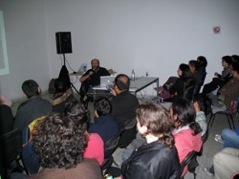

Tóxico is an independent cultural project based in Mexico City. Tóxico is a creative multidisciplinary think-tank, that organizes exclusive workshops and open lectures led by world-renowned artists, filmmakers, photographers, designers, writers, as well as hosting film screenings, exhibitions and collective art projects. Programs are hosted by partnering institution that provide facilities.
.jpg)
![]()
BORDER is a hyperactive, self-sustained center for art, new media, urban languages and graffiti. Alternating groups such as street artists, curators, new media creators and designers share their work in an exhibition space, and through workshops and events. A restaurant provides regular income for the hosting space.

Casa Vecina was launched in 2005 by private organisation as an active art space in Mexico Citys Centro Historico, a remodeled urban center by Fundación del Centro Histórico. Visual arts, literature and performing arts are part of their offering, along with project support, international residencies and educational resources that seek public intervention and community integration in the surrounding area.
![]()
Fundación/Colección Jumex is one the strongest art funding private initiatives in Mexico today. It develops talks, catalogues and film programs that accompany their exhibitions, and provides funding for institutional and independent art projects and education grants. Its educational and communication development has expanded through projects such as the TV documentary art series Arte en Construcción.

Newly formed museum initiatives include Campus Expandido, an academic seminar focusing on theoretical discourse analysis at Museo Universitario de Arte Contemporáneo. Estudio Abierto, at Museo de Arte Carrillo Gil, is a laboratory space and public program that challenges the museums relationship with its audience through space settings and event formats, programming film screenings, artistic debates, forums for independent publishers, and children’s programs.

El Jardín de Academus (Garden of Academus), opening Spring 2010, is an artistic pedagogical exhibition led by artist José Miguel González Casanova featuring 30 artist projects involving specific communities and pedagogical situations occupying a gallery space at MUAC (Museo Universitario de Arte Contemporáneo in México City). Casanova, an artist and art teacher for over 25 years, started Seminario de Medios Múltiples (Multiple Media Seminar) in 2004 at the National Arts School at UNAM exploring public interventions and community specific art.
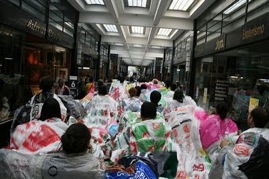
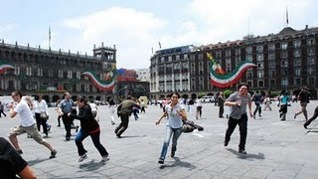
![]()
An innovator among art schools Escuela Superior de Arte de Yucatán, Visual Arts School in Mérida, Yucatán started in 2005 as a project led by Mónica Castillo, a prominent Mexican artist and the founder and former director of ESAY. Academic design was created through collective process integrating artistic, semiotic, historical and conceptual strategies to form a new generation of artists in the context of Merida, and in the framework of a the public structure of the Cultural Institute of Yucatán (ICY). Castillo has now taken a creative and critical distance, entering a two-and-a-half year research phase to deepen her reflections on this experience, as well as other issues of education and mediation, as part of the Art in Context MA program at Universitat der Kunst in Berlin.
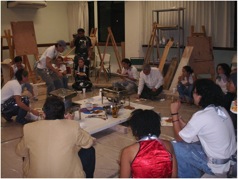
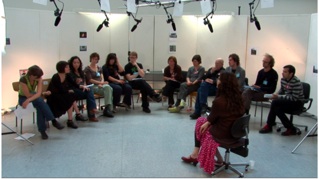
![]()
CEACO-La Curtiduría was started by artist Demián Flores and curator OlgaMargarita Dávila in Oaxaca as a residence and exhibition space for arts, with a study program of theory and practice workshop clinics with glocal invited artists.

Finally, FARO de Tláhuac, Fabrica de Artes y Oficios belongs to a network of community art centers that promotes cultural development in urban periphery run by the Secretary of Culture within Mexico Citys government. Collective, collaborative and self-sustained community projects are initiated in these centers.
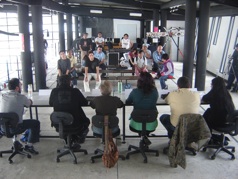
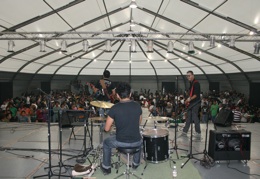
Thinking further
Questions arise from this increasing educational concern requiring a deeper reflection on each projects particular proposal, contextual relationship, and their possible effects on future cultural production.
How does each project understand its own role in education? Is there an explicit proposal or need to transform an idea of education and/or a pedagogical structure?
Are these projects critical commentary on education, or discursive propositions informed by the educational framework?
What is their relationship to experimental education initiatives outside the art field?
What is the nature of communities belonging to, created by, or approached by these programs?
What innovative modes of practice, organization, funding, operation and promotion are incorporated along with educational proposals?
How do projects such as these influence and transform our understanding of the parameters for art practice in relation to modes of practice used by other professionals?
How do they relate to the cultural, economic, and political conditions of public and private education in contemporary Mexico?
Can these projects have repercussions in broader social, political, and economic contexts in terms of the overall production of contemporary culture?
Knowledge of various perspectives and answers of these questions is needed to push forward a critical discussion on the development of educational panorama.
Work in progress: continuing the conversation at DISPATCH
Understanding a developing movement requires a dialogue that integrates multiple perspectives of current stakeholders. The author of this DISPATCH has invited artists and project initiators from the organizations and institutions outlined in this article to expand discussion. Contributing with specific information regarding their projects and positions, internal organizational structures, funding strategies, educational function, social engagement and long term projection of objectives in a self-reflective critical exercise, their participation will be added to this site during the following weeks.
Tóxico: Gabriella Gómez-Mont, founder and director
Published on February 12, 2010
SOMA: Yoshua Okón, founder and Eduardo Abaroa, academic director
Published on March 25, 2010 (Spanish)
Read the interview in English.
ESAY Visual Arts: Mónica Castillo, project leader and former director
Published on March 26, 2010 (Spanish)
Read the interview in English.
El Jardín de Academus: José Miguel González Casanova, founder
Published on March 28, 2010 (Spanish)
Read the interview in English.
Finally, participation in this platform is welcome through adding your comments. Please contribute to this conversation by emailing your comments to {encode=”info@curatorsintl.org” title=”info@curatorsintl.org”}. You will be notified if your comments are published.
Comments from the field
Oficina para proyectos de arte (OPA)
Published March 4, 2010
I would just like to mention that Sofia omitted talking about Oficina para Proyectos de Arte (OPA) in Guadalajara.
Founded in 2002 by artists: Jose Davila, Gonzalo Lebrija and Fernando Palomar, OPA is an artist run space, one of the few independent spaces still functioning in the country. In its program it has had exhibitons prepared specially for the space by artist like: Jim Lambie, Pipilotti Rist, Artemio, Kendell Geers, Anri Sala, Pedro Cabrita Reis, Christian Jankowski, Monica Sowsnoska, among others. There has also been some curated shows by: Guillermo Santamarina, Pip Day, Patrick Charpenel, Mario García Torres and Patricia Martin. This year will feature exhibitions by Saadane Afif, Manfred Pernice, John Isaacs, Carlos Bunga, and Superflex in february 2011.
Besides OPA, Guadalajara in general has become an important center for production of art, specially through the work of collector José Noé Suro, as well as other mayor individual contemporary art collectors. Although it has always lacked of a public cultural program (its few museums never have budget to host shows, other than local artists), and it has always been neglected by the capital city, for everything in Mexico is super centralized, including federal budget, Guadalajara has had spaces like OPA, and promoters and artists, that transcend our borders.
